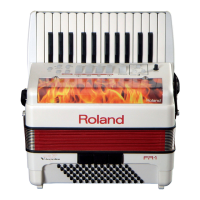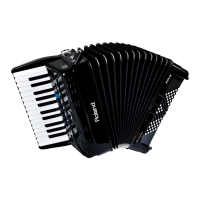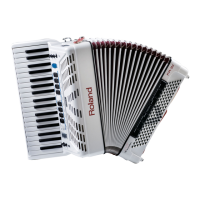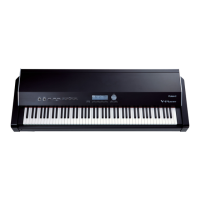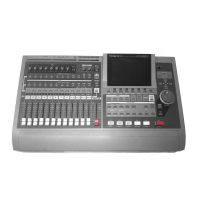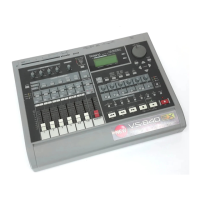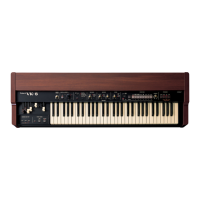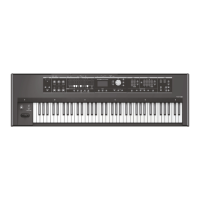Highlighting some practical functions
34
r
V-Accordion FR-18 diatonic
The numbers above the first row of the treble button
keyboard will help you choose and save the right tab-
lature.
4.
Press the [SET] register once to exit Func-
tion mode.
NOTE
Each time you switch on the FR-18 diatonic, it will load the
tablature whose number you saved.
Using the metronome
Your FR-18 diatonic contains a metronome that may
come in handy when you are practising new pieces, or
during your accordion classes.
1.
To start or stop the metronome, press and
hold the [SET] register and press register [3]
(METRON).
NOTE
See “Metronome Time Signature” on p. 44, “Metronome
Tempo” on p. 44 and “Metronome Level” on p. 44 for how
to set the metronome’s time signature, tempo and level.
NOTE
If you hold down [SET] for more than 2 seconds without
pressing another register, the FR-18 diatonic switches to
Function mode. In that case, press [SET] again to leave that
mode, then repeat step (1).
Checking the battery status
If you are using batteries, to check the current charge
status of the batteries:
1.
Press and hold the [LEFT REGISTER] button.
Depending on the battery charge status, register [1]~
[4] will progressively light for a short while. After ±2
seconds, the registers return to the following situa-
tion.
If all (red and green) registers are lit, the batteries are
fully charged. If only the red registers light, the
remaining battery life is about 1 hour.
NOTE
To check how your FR-18 diatonic is currently powered,
press and hold the [LEFT REGISTER] button:
If the [DRUM] button and the first two registers light dur-
ing operation, the FR-18 diatonic is powered by the sup-
plied adaptor.
If the [ORCHESTRA] button lights, batteries are used to
power the FR-18 diatonic.
NOTE
The battery charge indication is only an approximation.
Musette Detune
An accordion’s 8’ treble register may consist of 2 or even
3 reeds that are usually tuned apart to provide a richer
sound (accordionists call it the “musette effect”). One
reed is tuned slightly above, the other slightly below the
correct pitch (and the third, if available, is tuned “prop-
erly”).
The FR-18 diatonic allows you to choose from among 15
different detune settings. These are called “1” (Dry),
“2” (Classic), “3” (F-Folk), “4” (American L),
“5” (American_H), “6” (North Eur), “7” (German L),
“8” (D-Folk L), “9” (Italian L), “10” (German H),
“11” (Alpine), “12” (Italian H), “13” (D-Folk H),
“14” (French), “15” (Scottish).
See “Musette Detune ” on p. 43 for how to select the
desired Musette detuning.
NOTE
“Musette Detune” only affects registers that use the 8’ reed.
FR-18d GB.book Page 34 Wednesday, December 15, 2010 1:54 PM

